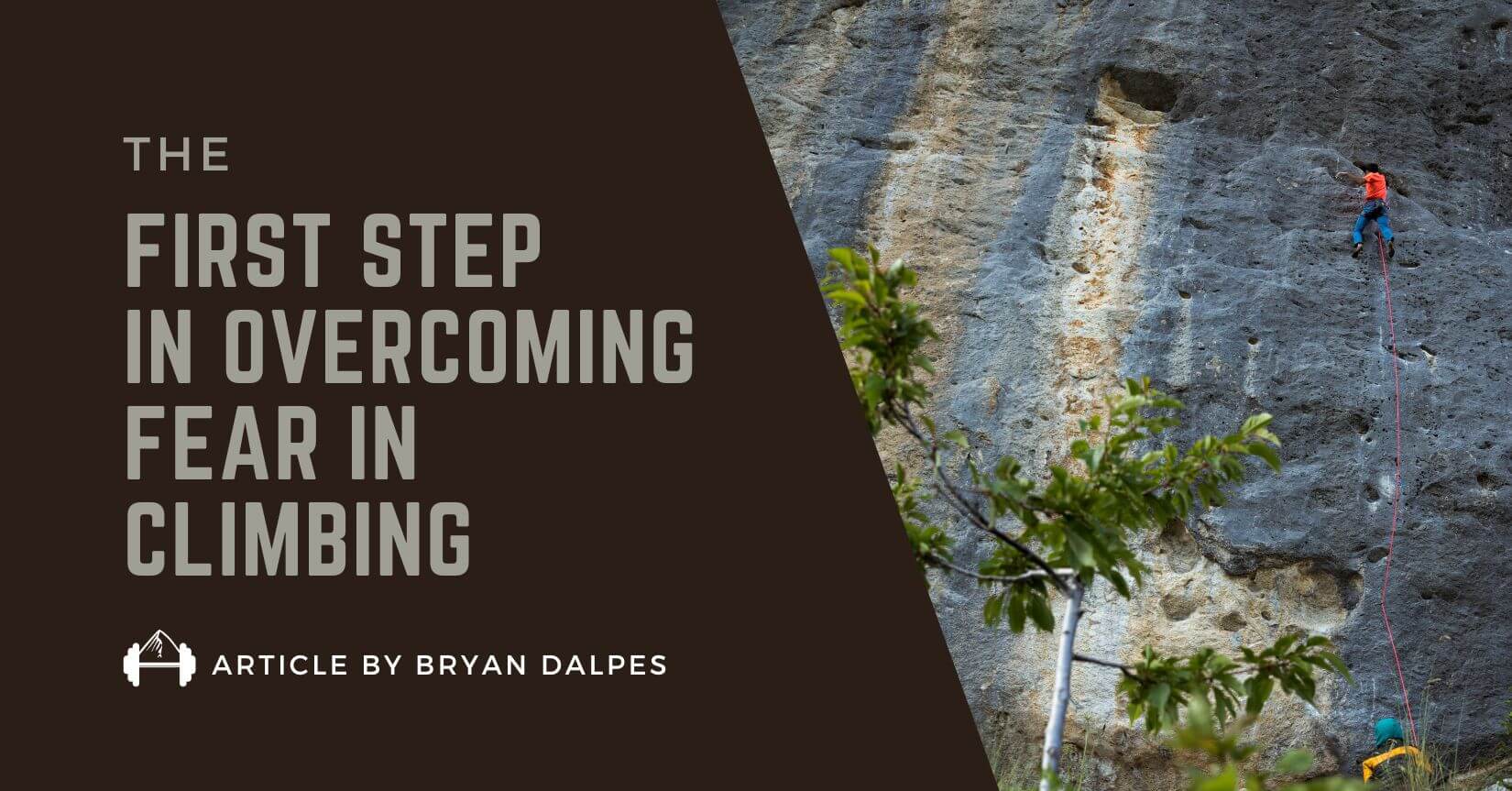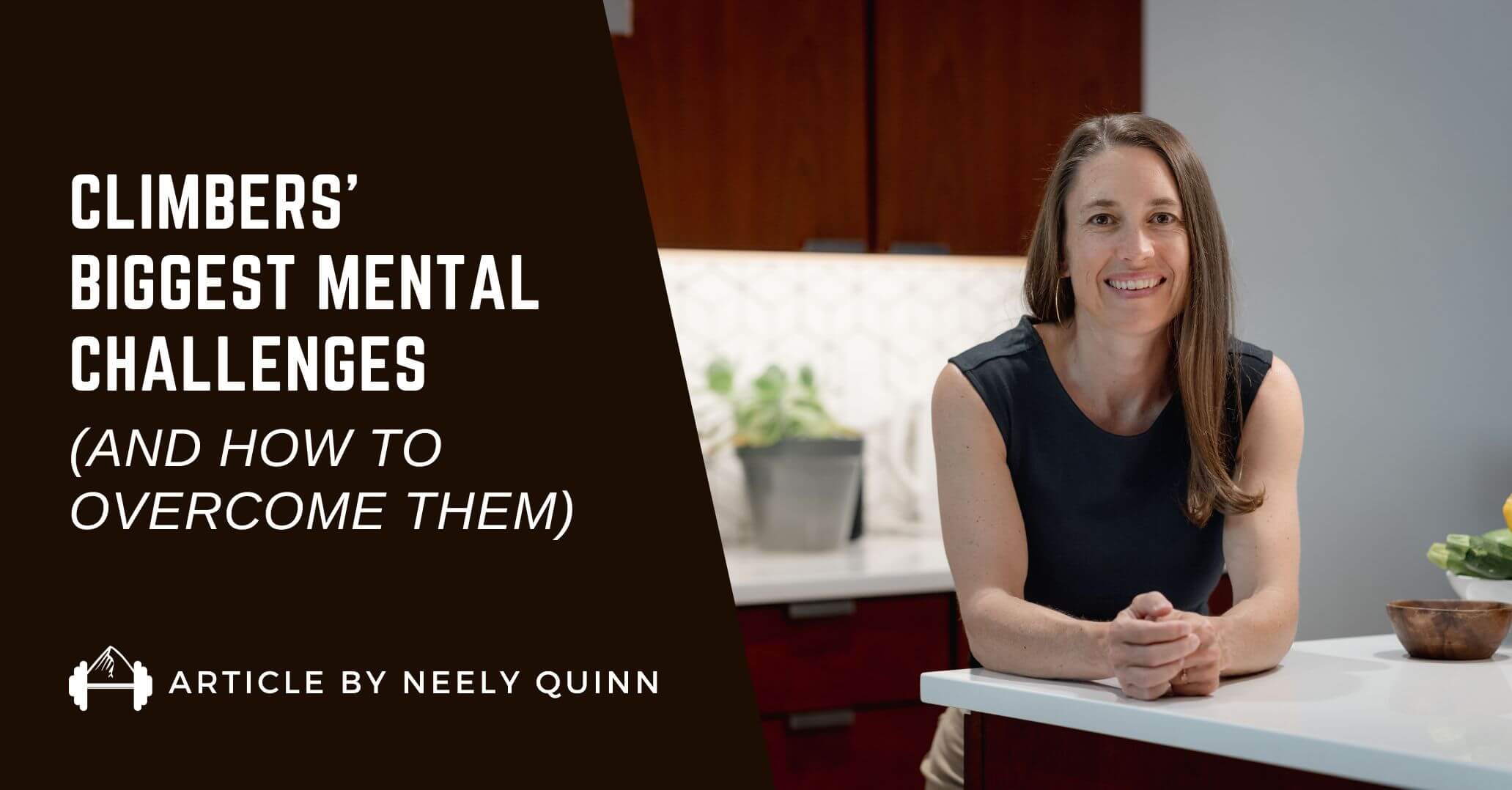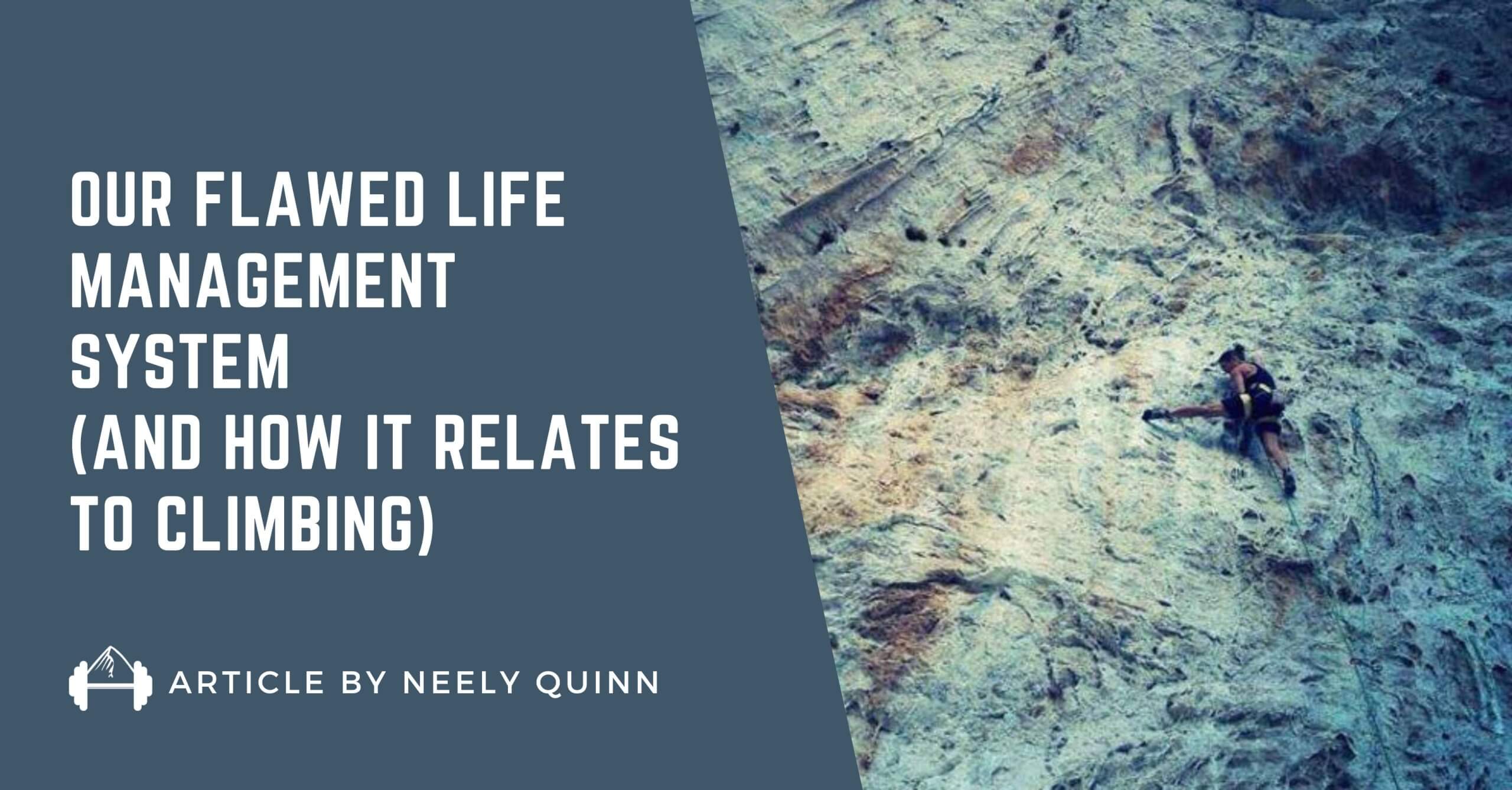The First Step in Moving Past Unnecessary Fear in Climbing
By Bryan Dalpes, Mindset and Mental Fitness Coach
If you have struggled with intense fear in climbing then you know it can be a confusing and frustrating journey. Thoughts like, “I know I can physically do these moves but I just get freaked out” are omnipresent and often cycle over and over like a broken record. Being at the mercy of unnecessary and limiting fear is exhausting and sucks the joy from our climbing experience. You may have tried things like fall practice or mantras in the past with little or even negative results.
In this article I will discuss one of the main reasons climbers struggle with unnecessary fear and give a simple, practical exercise you can do to understand and move past the fear so you can push your personal limits and have more fun climbing!
A Simple Miscommunication
Your brain’s number one priority is to keep you safe, period. Over thousands of years of evolution our brains developed what is called the Negativity Bias. Simply put, negative experiences have a much more significant effect on us than positive ones, even if they are of similar magnitude. This is a safety mechanism. It is of great benefit to learn that fire will burn you the first time you get too close. Therefore the experience is seared (pun intended) into your memory. But this negativity bias has another function. It keeps us on alert, always scanning for threat and danger.
Think about walking through the woods and hearing a rustle in the bushes behind you. Is your first instinct to think, “Oh, it’s probably a small, harmless critter rooting around”? Or do you automatically assume it’s a bloodthirsty predator and flee in the opposite direction gasping in terror? Of course it’s the latter because for the survival of our species we didn’t have the luxury of assuming wrong and being eaten. Our brains must constantly be searching for and expecting danger.
So here’s the conundrum…rock climbing is (relatively) dangerous! This is where the tension occurs. Our brains’ sole job is to protect us, but often, our hearts’ deepest longing is for the adventure, novelty, excitement, challenge, connection and exploration that climbing offers. All of these things can freak our brains out! Doesn’t it make sense that our brain may have a thing or two to say about this heart that wants to run off to do these crazy adventures and flaunt danger?
But here’s the thing: we don’t always acknowledge that our brain has these concerns. In fact, we often chastise our brain for being the fun police. Have you ever thought to yourself, “I wish I could just shut my brain off?” Or, “I just need to learn to push through the fear.” Both of these thoughts suggest that the brain is somehow wrong for being concerned about your safety.
What if we approached this issue in a different way?
Imagine your brain is a very loving, very (sometimes overly) concerned friend or family member. They love you more than anything and all they want is for you to be safe, happy and healthy.
One day you decide to take them rock climbing. You don’t explain too much to them beyond, “It’s going to be so fun! You’ll love it!” As you approach the base of the cliff your friend starts to have some concerns. They’re not comfortable with the situation and they express this to you clearly. They look at the dark foreboding cliff and feel a deep sense of dread. Scanning the confusing system of unfamiliar climbing gadgets they feel disoriented as the panic starts to build in their chest. They can’t for the life of them understand why you are dragging them out to do this dangerous and reckless activity. With sweaty palms and quickening breath all they can see are the myriad ways to get injured or worse.
How would you react to this person you care about and who cares deeply for you? My guess is you would show them care and compassion. You might ask them questions about what they’re experiencing. What frightens them the most? You might explain how the gear works and that it’s rated for far more force than a human can normally apply to it.
They likely would want to know why you insist on doing this climbing activity. You could tell them how exhilarating it is. How when you get into the flow everything else drops away and you are completely focused in the present moment. How fulfilled and accomplished you feel when you complete a difficult route that was chalked full of unknowns and uncertainty. How learning skills through rock climbing transfer over to many parts of your life and helps you build confidence. You would tell them about the amazing partnerships that climbing cultivates and the beautiful places it can take you. If you had foresight and were being especially supportive you would say all this before standing at the base of the cliff so that they had time to mentally prepare. This would give your friend a glimpse into this magical world and they would likely be more calm and intrigued on trying it for themselves or at least understand why it’s so important to you.
But we often don’t do this with our own brains.
Instead, we repeatedly expose them to mildly traumatic situations and then feel shame and embarrassment for being frightened, especially if there are others around us who don’t seem to be affected the same way. We feel that there is something wrong with us or that we are weak or foolish. We get frustrated with our faulty brains and wish they were different (i.e. better) than they are. We wish we could turn them off so they stop ruining our fun. Essentially, we shame and chastise this wonderful brain that is simply looking out for us in the best way it currently knows how. Can you imagine if you did this with the people who care about you? Over and over we force them back to the cliff or the gym. Repeatedly subjecting them to situations that they have clearly expressed causes them to feel unsafe, unheard and uncared for.
This leads to our brains becoming preactivated with a cascade of building anxiety long before even touching a hold. We then rush through the climbs we attempt (if we attempt them at all). We are unable to stay present or attentive while climbing and having little enjoyment or even memory of the experience beyond the discomfort and fear. Or we may become so fear stricken and tunnel visioned that we freeze part way up the climb needing to be lowered to the ground while we are filled with more shame and frustration having “failed” on such “easy” climbs.
One interesting piece to note is, the experience of being “paralyzed” on a climb can be terrifying and confusing, but in reality it makes complete sense. It’s basically your brain saying, “Alright, I’ve had enough, you’re not giving me what I need and I’m shutting the system down to get us back on the ground where we’re safe.” Many people think that they are mentally weak or that something is wrong with them when they have this experience but it’s actually proof that you have a very strong, well functioning brain. It is so determined to keep you safe that it will override your entire system when it feels this is the best option.
The key is to recognize that your brain needs more care and information to be able to understand and build skills to ultimately accept what your heart longs for, all the beauty, confidence, satisfaction and fulfillment that is available through the act of climbing.
So what do we do?
Your Brain and Your Heart Need to Have a Conversation
Like any relationship, especially one that’s on the rocks, communication is key. The wounds of the past need to be repaired and a clear understanding must be reached. The easiest and most efficient way to do this is to remove climbing from the conversation initially. I know, this is an article aboutfear and climbing but hear me out…
When our brain has been repeatedly subjected to situations which have caused stress or trauma it will learn to be on high alert for the next threat. The “threat” in this case occurs at some point during climbing. It may be difficult to pinpoint the exact moment at which a fun day climbing turns into a fearful experience. Since our brains typically don’t like uncertainty, this can cause tension to begin building before we ever lay our hands on a hold. Our brains are searching for something to fear before we’ve even begun. You can imagine how this would make it difficult to learn new skills in dealing with fear. But, if we are able to practice new skills in a safe, calm state we can build and strengthen the neural pathways so that they are ready to be used when we do return to the situation that was previously stressful. Think of it as going “under the radar” of your negativity bias.
Below I will introduce an exercise that will help you start to train your brain and begin on your path to a new experience of fear and climbing.
First, We Must H.E.A.L.
I learned of this simple yet powerful exercise from neuropsychologist Dr. Rick Hanson (If you would like to learn more check out his TEDx talk). Dr. Hanson developed this exercise over the course of his career studying neuropsychology and has used it extensively in his psychology practice and meditation teaching. I’ll explain below…
Step 1: Have a positive experience.
Dr. Hanson states, “The interesting thing is that most of the wholesome qualities of mind and heart that help us cope with life, including coping with hard things, most of those inner strengths are built from positive experiences of those strengths.” Dr. Hanson suggests that we can strengthen our confidence, resilience or courage, for example, by remembering times in our lives when we have experienced these things. So if we would like to experience less fear while climbing it is crucial that we practice finding times in our lives where we felt confident, composed, competent, courageous, etc. and practice recreating those experiences. Remember that we want to avoid setting off the alarm bells in our brain so it is best to start with something non climbing related.
Action:
Think of a time that you felt deeply cared for by someone in your life. It could be a person (or dog!) from the present or past. As you begin to remember the event, stay with it. Allow it to flow from concept to experience. You are helping this thought become a feeling in the body. This experience needs to last long enough to transfer from short-term memory to long term storage.
Step 2: Enrich it.
The negativity bias makes it difficult to stay focused on the positive experiences in our lives which hinders our ability to learn new things and grow. Because of this we need to be intentional about allowing positive experiences to “stick” in the brain.
Action: Enrich the experience.
To do this, keep coming back to the positive thought. As your brain tries to wander elsewhere, gently bring it back to the moment and the person whom you felt cared for by. As you do this you will notice the feeling begin to grow and intensify.
Step 3: Absorb it.
Studies show that because the negativity bias is so strong we need up to a 5:1 ratio of positive experience to negative for it to activate the corresponding neurotransmitters. This means to have lasting change in our ability to move past experiences of fear, for example, we have to put in some work!
Action:
Let the experience sink into you. Imagine the feeling sinking into your cells. Intently envision the feeling becoming part of you. This will prime and strengthen the memory centers and neural pathways.
<***A quick word of caution: You may want to practice the first three steps a few times until you are able to reliably stay in the positive experience so that you are not “hijacked” by the negativity bias. Also, please remember, this exercise is not about pushing out, blocking or ignoring negative experiences. It is simply to train the brain to be more able and efficient at building neural pathways so that we can shift our attention to what we would rather be focusing on rather than excessively focusing on the negative.
Step 4: Link it to the negative.
The phrase “Neurons that fire together wire together” is common in the world of neuro-science. When we are able to intentionally move back and forth from positive experiences to negative ones without becoming overwhelmed by either, we are able to make clear choices between the two. In climbing this is a crucial skill that we need to stay safe by noticing when there is perceived danger versus real danger. We need to have the capacity to make clear, calculated and efficient decisions to keep us out of harm’s way. This is very difficult if we are panicked or overwhelmed. This is where this exercise becomes especially powerful if it is done well.
Action:
When you are feeling strong in the positive experience, think of something negative. For example the last time you backed off a climb you knew you could do. Or didn’t try that boulder problem because you felt intimidated by the amount of people watching. You don’t want it to be too big of an event but impactful enough that you have thought about it several times since. Pay attention as you shift from from the positive to the negative. What do you notice?
After a few seconds thinking about the negative, come back to the positive and let that experience absorb again. Do this back and forth three times, being mindful to stay in the positive space as much as five times longer than the negative space. Overtime, with practice, your brain will more easily move from those negative, recurring thoughts and into the positive experience where you are able to take steps toward what you really want.
As you build this brain muscle, begin to incorporate more climbing related experience into your practice. One way to think of using it is as “warming up” your neurotransmitters to be ready to use when you are on the wall. Just like we warm our fingers and muscles we plan to use while climbing, we also want to warm up the transmitters we would like to use as we mentally maneuver our way up a climb. Try incorporating the HEAL exercise into your normal warm up routine to start your climbing session with more focus, attention and mental toughness.
If you are at the gym or crag and you notice that you’re experiencing fear that seems irrational, find a quiet spot and work through the HEAL exercise (again just use the first three steps initially) to help your brain shift focus away from excessive negative thoughts and on to what experience you would love to be having during your climbing day.
Be kind and gentle with yourself. It took a long time for these fears to manifest and it will likely take some effort to learn how to consistently shift away from them. Be patient and take small steps. There is a Buddhist saying that captures the process beautifully.
“Do not think lightly of good, saying it will not come to me. Drop by drop is the water pot filled. Likewise, the wise one, gathering it little by little, fills oneself with good.”
Summary of the H.E.A.L. Exercise
- Have a positive experience
- Enrich it
- Absorb it
- Link it to the negative
In Conclusion
Struggling with overwhelming or unwelcome fear can be incredibly frustrating and feel hopeless at times. Unchecked it drains the joy from our climbing and ultimately impacts ours and our partners’ experience.
But fear is totally normal, natural and vital to our safety. It is our job to pay attention to what our brains need and practice skills to be able to operate safely, comfortably and efficiently in climbing situations.
When our brain and body are working in harmony we can push our physical and mental limits and our climbing becomes truly joyful.
The exercise above is just the beginning. Please feel free to reach out if you have any questions about this exercise. If you would like to learn more about training your brain to have a new relationship with fear in climbing, maximize your mental potential and have a blast climbing again, please visit my website at www.mountainmindset.net. Check out the “Free Stuff” page and consider booking a free 45 minute consultation.
About the Author
Bryan Dalpes is a mindset and mental fitness coach based in Missoula, MT. While working as a mountain guide in Alaska, he became fascinated with how fear and uncertainty would routinely derail his clients goals and their ability to enjoy their experience while moving through stunning mountain terrain.
In spring of 2020 Bryan began formally training in mindset and mental fitness with the Academy of Coaching Excellence. While also informally training by obsessively consuming every book, article, podcast, YouTube video, etc. on fear, mindset, and mental fitness that he could get his hands on.
Through this training combined with his experience guiding, instructing, firefighting, ski patrolling and nearly 20 years of climbing he has created a process to help climbers move past unhelpful, irrational or overwhelming fear.
If you are experiencing similar fear and would love to get back to climbing hard and, more importantly, having fun, visit the website to learn more about his philosophy and methods or get in touch for a free 45 minute consultation.
- Website: https://www.mountainmindset.net
- Email: bryandalpescoaching@gmail.com
- Instagram: @bryandalpes
- Facebook: https://www.facebook.com/bryan.dalpes








Leave A Comment